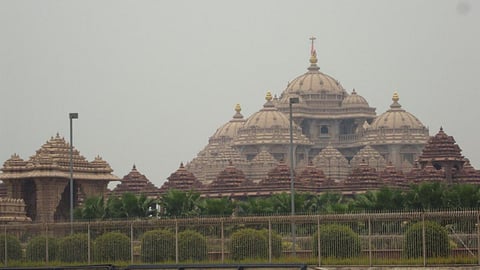
- Topics
- Feature
- Opportunities & Events
- About
- Hindi Portal
- Data
- Topics
- Feature
- Opportunities & Events
- About
- Hindi Portal
- Data

Recent permission granted to the Art of Living to hold the World Culture Festival in the Yamuna floodplains points fingers yet again at the fact that not much has been done to assure its safety. The rapid encroachment of the Yamuna floodplain has raised a few questions. Can the river sustain the rampant commercialisation of its floodplains? Are there national or state legislations that provide statutory protection to rivers as an ecological entity? Manoj Misra of Yamuna Jiye Abhiyaan discusses some of these issues.
The reason we have focused on the protection of the floodplains of rivers as being top priority and of no less if not more critical importance than maintaining environmental flows in them, is the problem that vests in the current understanding of rivers and everybody's obsession with merely cleaning them as an end in itself. This is because when we restrict our goal to cleaning our rivers we end up equating our rivers with just the water flowing in them, as if our rivers are no more than manmade canals. And therein lies the root cause of all our failures with river cleaning efforts since 1994, when the Ganga Action Plan was launched with much fanfare.
We must understand that a river, an ecosystem is a longitudinal and lateral unbroken continuum where its flood plains form a natural extension of it, and where many river related functions like aquifer recharge, natural cleaning of surface waters, habitat of riparian flora and fauna, and completion of the life cycle of many aquatic species take place.
A river bereft of its floodplain is like a limb less human, unable to realise its full potential. Thus when a floodplain function is converted into river incompatible uses, whether commercial or not, we are striking at the very vitals of a river ecosystem.
Floodplains have often been compromised by either building embankments close to the river channel and then utilising the land thus presumed to have been secured from flooding for uses like human habitation, industries, by practicing chemical agriculture on it or mining of sand etc.
We believe that a healthy river must flow as well as flood freely. To flood is as natural a phenomenon in rivers as are low ambient temperatures in winter and high ambient temperatures in summers. So when man tries to control floods he/she is indulging in an unnatural act. The fact is that when we try to control floods, they turn far more devastating than they would be otherwise for humans inhabiting in or near the floodplains.
A river is a natural entity and it has all the capability to meet the needs of all those dependent on it, including humans, provided it is allowed to be and not looked upon just as a channel of utilisable water.
There are still no national or state legislations that provide statutory protection to rivers as an ecological entity. Thus, even the Environment Impact Assessment Notification has no regulation that covers the integrity of a river system other than regulations that oversee construction of buildings (in floodplains) or planning a hydropower or irrigation project on a river.
The High Court likewise looks at river encroachments under Public Interest Litigation and the National Green Tribunal (NGT) under questions of larger environmental interest. Though it must be admitted that with the coming in force of the NGT, there is far more effective legal space available for safeguarding rivers. Both the Commonwealth Games village and the Metro depot came up before the formation of the NGT.
The Delhi Development Authority’s Master Plan 2021 has while identifying the river zone (Zone O) as a planning zone in the city, not specifically provided any statutory protection to it. In any case the Master Plan with provision of making a change in the designated land use is often misused to regularise encroachments.
NGT has issued notices to the respondents, which includes Delhi Development Authority, Delhi Government and the Art of Living Foundation returnable on February 17, 2016. We await further actions in the matter at the NGT.
Yes, indeed the art of killing the rivers is gaining newer ways.